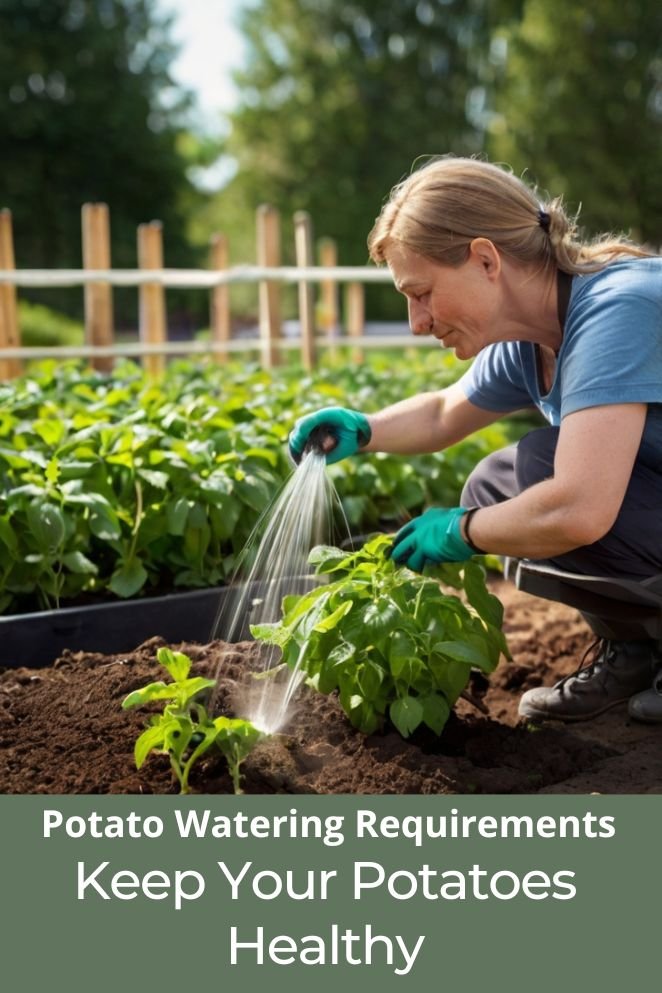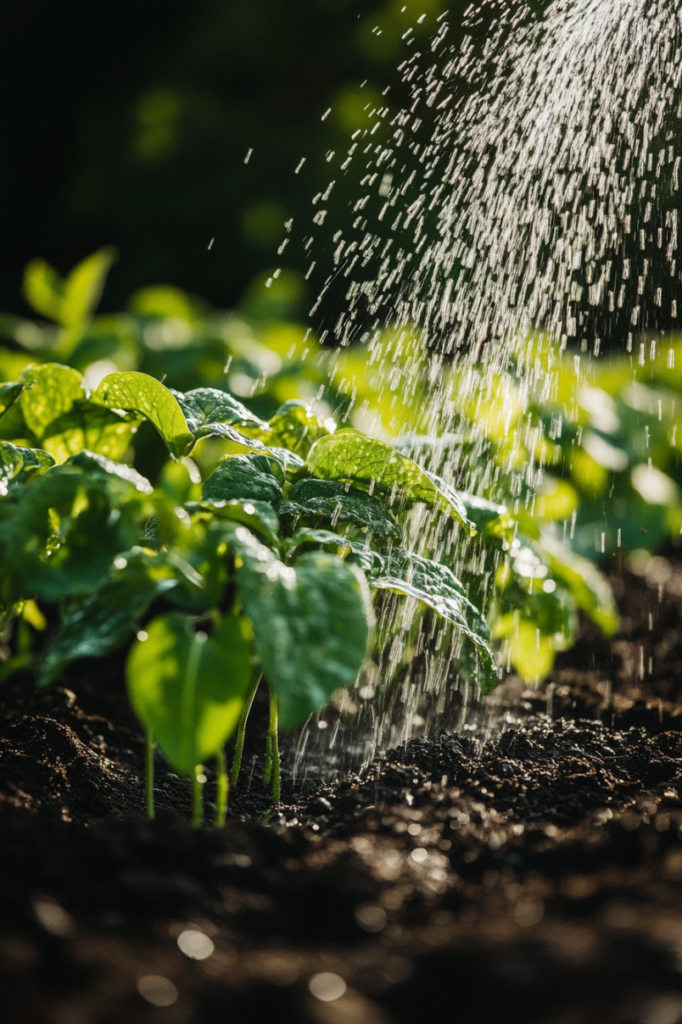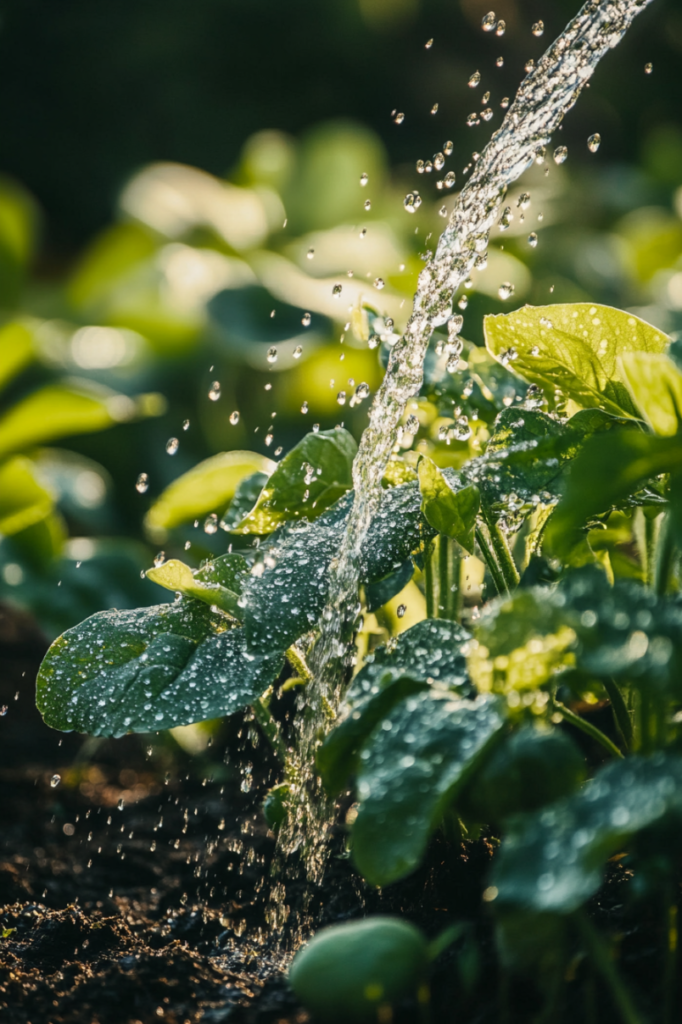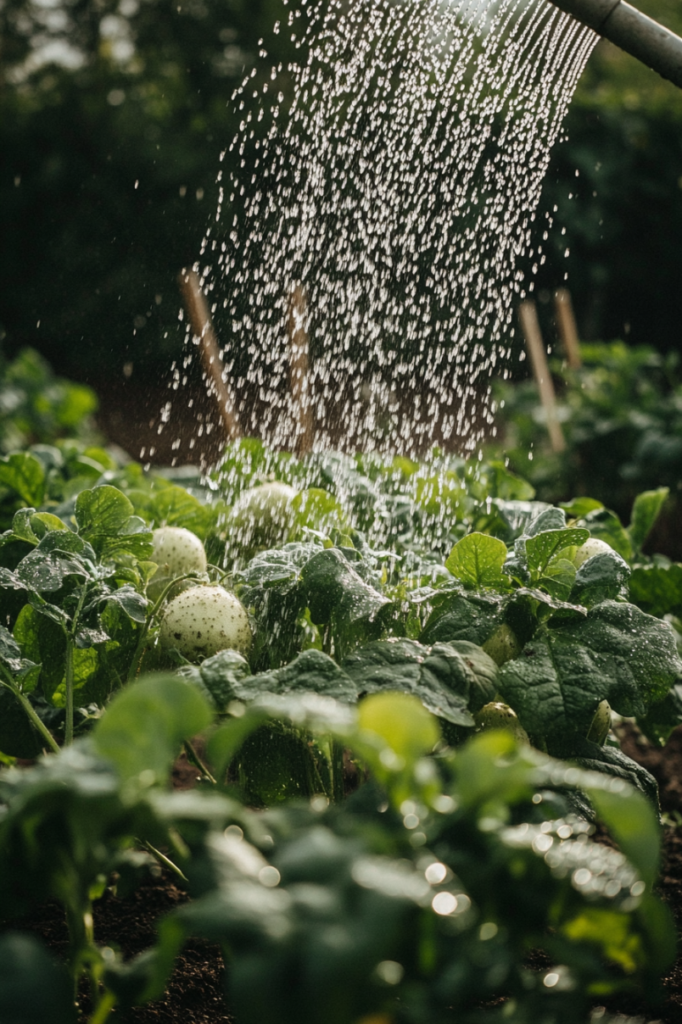
Potatoes are versatile and relatively easy to grow, but they do require specific conditions to thrive.
One of the most crucial aspects of potato cultivation is watering.
Too little or too much water can affect the health of the plants and the quality of the tubers.
By understanding and managing potato watering requirements, you can ensure a successful harvest.
Understanding Potato Water Needs
Potatoes require consistent moisture throughout their growing period. Here’s a breakdown of their water needs:
Water needs during different growth stages
Germination and early growth
When you first plant potatoes, they need plenty of moisture to encourage sprouting and root development.
During this stage, keep the soil consistently moist.
However, avoid making it waterlogged, as too much water can harm the young plants.
Proper moisture at this stage is crucial for strong, healthy growth.
- Read also: DIY Potato Planter Box: A Step-by-Step Guide to Growing Spuds
- Read also: The Ultimate Guide to Companion Plant for Luscious Potatoes
Vegetative growth
As potato plants grow and develop their stems and leaves, they require regular watering.
Consistent moisture supports their overall growth and helps the plants stay healthy.
If the soil gets too dry or fluctuates in moisture, the plants might not grow as well or may develop poorly.
Tuber formation and bulking
This is the most important time for watering potatoes.
As the tubers start to form and expand, they need a lot of water to grow properly.
Ensuring adequate moisture during this period is essential for producing large, well-shaped tubers.
If the soil is too dry, the tubers might end up small or misshapen.
Maturation
When the potatoes are nearing harvest time, you should gradually reduce watering.
This helps the skins of the potatoes toughen up, which is important for their storage life.
Be cautious not to stop watering suddenly, as this can lead to issues like blossom end rot, where the potatoes can develop dark, sunken spots on their ends.
Soil moisture levels
Potatoes thrive in soil that is consistently moist but well-drained.
The soil should be moist to a depth of about 6-8 inches.
You can check soil moisture using a soil moisture meter or simply by sticking your finger into the soil.
It should feel damp but not soggy.
Proper soil moisture helps ensure healthy plant growth and good tuber development.

Watering Techniques
To keep your potato plants properly watered, you can use various watering techniques.
Here’s a detailed look at each method:
Drip irrigation
Drip irrigation is a highly efficient way to water your potatoes.
It uses a system of tubes and emitters to deliver water directly to the plant roots.
This targeted approach minimizes water waste and ensures that each plant gets the right amount of moisture.
According to the USDA, drip irrigation can save up to 50% more water compared to traditional methods.
It works well for both large garden beds and container setups, making it a versatile choice.
Soaker hoses
Soaker hoses are another effective watering option.
These hoses are designed to release water slowly along their entire length.
You can lay them on the soil surface or bury them under mulch.
Soaker hoses provide even, consistent moisture and are especially useful for larger potato beds.
They help reduce the risk of overwatering and ensure that water is distributed evenly across the garden.
Hand watering
Hand watering with a hose or watering can is a more hands-on approach.
This method works well for smaller gardens or container plants where you need precise control over the amount of water each plant receives.
While effective, it does require more time and effort to ensure that all plants are watered evenly.
Sprinklers
Sprinklers can also be used for watering potatoes, but they’re generally less efficient than drip irrigation or soaker hoses.
Sprinklers can lead to water wastage and may cause issues with plant diseases due to wet foliage.
If you choose to use sprinklers, make sure to adjust them so that water focuses on the soil rather than the leaves to minimize these risks.

Watering Schedule
A consistent watering schedule is crucial for keeping your potato plants healthy throughout their growing period.
Here’s a detailed guide for watering potatoes at each growth stage:
Early growth stage
- Frequency: Water your potato plants as needed to keep the soil consistently moist. This helps the plants establish themselves after planting.
- Amount: Make sure the soil is moist to a depth of about 6 inches. The goal is to keep the soil evenly damp, not soaked, which helps the young plants develop strong roots.
Vegetative growth
- Frequency: Water your plants once or twice a week, adjusting based on rainfall and temperature. If it’s hot and dry, you might need to water more frequently.
- Amount: Apply enough water to reach the root zone but avoid making the soil soggy. Proper moisture helps the plants grow healthy stems and leaves.
Tuber formation
- Frequency: Water deeply and consistently, about twice a week. This stage is critical for tuber development, so consistent moisture is important.
- Amount: Increase the water amount to ensure the soil remains moist. This supports the growth of large, well-formed tubers. Make sure the soil stays moist but not waterlogged.
Maturation
- Frequency: As your potatoes approach harvest time, reduce the frequency of watering. This helps the potato skins toughen up, which is important for storage.
- Amount: Cut back on the amount of water applied, but keep an eye on the soil to ensure it doesn’t dry out completely. You want to balance between drying the soil enough for good skin development and preventing excessive dryness that could harm the potatoes.
Troubleshooting Common Watering Issues

Even with the best intentions, watering issues can arise. Here are some common problems and how to address them:
Overwatering
Symptoms
Overwatering is a common problem for potato plants, and it can lead to several visible issues:
- Yellowing leaves: When plants receive too much water, their leaves may start turning yellow. This happens because excess moisture can suffocate the roots and interfere with nutrient uptake.
- Root rot: Constantly soggy soil creates a breeding ground for fungi and bacteria that can cause root rot.
- Soggy soil: If the soil remains wet and waterlogged for too long, it means you’re likely overwatering. Healthy soil should be moist but not soaking wet.
Solution
To correct overwatering and its effects, follow these steps:
- Improve soil drainage: Start by enhancing the soil’s ability to drain excess water. You can do this by adding organic matter like compost or well-rotted manure.
- Adjust watering frequency: Cut back on how often you water your plants. Instead of watering on a strict schedule, check the soil moisture first.
- Monitor soil moisture: Regularly check the soil’s moisture level to ensure it’s not too wet. A simple way to do this is by sticking your finger into the soil up to the first knuckle.
Underwatering
Symptoms
- Wilting plants: When potato plants don’t get enough water, their leaves and stems can start to droop and wilt.
- Dry soil: If the soil around your potato plants feels dry to the touch, it’s a clear sign that it hasn’t received enough water. Plants need a consistently moist environment to thrive.
- Smaller-than-normal tubers: If the plants are not getting enough moisture, the tubers may not grow to their full potential and may be smaller than usual.
Solution
- Increase watering frequency: Start by watering your plants more often. Check the soil regularly and water it whenever the top inch feels dry.
- Water deeply: When you water, make sure to apply enough water so that it reaches the root zone.
- Use mulch: Adding a layer of mulch around your plants can be very helpful. Mulch helps retain soil moisture by reducing evaporation and keeping the soil cooler.
Uneven watering
Symptoms
- Patchy growth: If you see that some parts of your garden have healthy, lush plants while other areas look sparse or underdeveloped, it may be a sign of uneven watering.
- Varying sizes of tubers: When potatoes don’t get an even amount of water, the tubers can grow at different rates.
Solution
- Use a soaker hose: By laying it out on the soil, you can ensure that water seeps evenly into the soil, reaching all the plants.
- Install a drip irrigation system: Drip irrigation systems are highly effective for even water distribution.
- Adjust your setup: Whether you’re using a soaker hose or a drip irrigation system, make sure to adjust the layout to cover the entire area where your potatoes are growing.
Water quality
Symptoms
- Poor plant health: If your plants are struggling, showing signs of stress, or not growing as expected, water quality could be a factor.
- Unusual growth: If the plants exhibit strange growth patterns, like discolored or misshapen leaves and tubers, it might be due to impurities or high levels of salts in the water.
Solution
- Use clean, non-saline water: Salty water can harm plants by affecting their ability to absorb nutrients.
- Install a water filter: If your water source is hard or has high levels of dissolved salts, consider installing a water filter.
- Find an alternate water source: If filtering isn’t an option, look for a different water source that is known to have better quality.

- Read also: Spudtacular Sprouts: The Ultimate DIY Potato Grow Bag Guide
- Read also: Spudtacular Sprouts: Build Your Own DIY Potato Tower Planter
Conclusion
Proper watering is crucial for growing healthy, productive potato plants.
By understanding the specific water needs of potatoes and implementing effective watering techniques, you can improve your chances of a successful harvest.
Whether you choose drip irrigation, soaker hoses, or hand watering, maintaining a consistent watering schedule and addressing common issues promptly will help your potato plants thrive.
FAQs
Yes, but ensure that your tap water is not too hard or saline. If necessary, use a water filter to improve water quality.
Signs include yellowing leaves, soggy soil, and root rot. Reduce watering and improve soil drainage if these symptoms occur.
Water potatoes to a depth of 6-8 inches. This ensures that the entire root zone is adequately moist.
Sprinklers can be used but are less efficient. They may lead to water wastage and potential leaf diseases. Drip irrigation or soaker hoses are preferred for more efficient watering.



